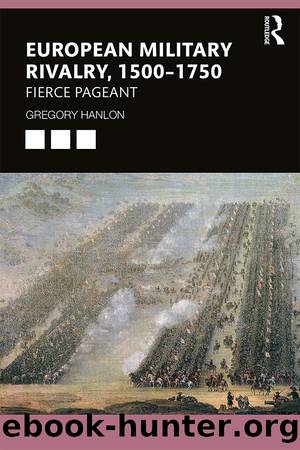European Military Rivalry, 1500â1750 by Gregory Hanlon

Author:Gregory Hanlon [Hanlon, Gregory]
Language: eng
Format: epub
Tags: History, General, Europe, Military, Weapons, Naval, Napoleonic Wars, Revolutionary, Modern, 17th Century, 18th Century, 16th Century, Social History
ISBN: 9780429768408
Google: 5CnZDwAAQBAJ
Publisher: Routledge
Published: 2020-03-26T03:41:40+00:00
New Hungary wars
After the Peace of 1606, the Habsburgs relied on their militia auxiliaries to defend the 1,000 kilometres of frontier with the Turks that Jean Nouzille calls the âIron Curtain of Christendomâ. This band of territory, detached from royal Hungary 30â90 kilometres deep, stretching from the Adriatic Sea to the Carpathian Mountains, was inhabited mainly by Serbian Orthodox refugees from the Balkans.62 Peasant freedom there attracted serfs from Hungarian and Croatian estates, infuriating the kingdomâs magnates. These irregulars formed a light infantry the Germans called grenzers, who protected their districts from Ottoman raids and then carried the war into Bosnia and Ottoman Hungary. On the Christian side of the border, villages were often abandoned due to insecurity and few communities had permanent houses. People tried to protect themselves from raiders on horseback by barricading themselves in churches or castles.63 On the Ottoman side, janissaries received pay from the treasury, but irregular soldiers and auxiliaries relied on raiding for a living.64 These forays were clear violations of the treaty, but the ghazi tradition of holy war against miscreants was irrepressible. Ransom slavery reached its peak in Hungary in the decades prior to 1663. Many men were ready to participate, in the hope of bringing home rich captives. Prisoners able to pay a steep ransom were confined to forts and towns not too far from the border. Poor captives were simply shipped off to Sarajevo or Istanbul to be sold as slaves. Considerable numbers of captives were taken by Tatars or by local irregular bands of armed men. Auxiliary Tatars scoured Transylvania and Slovakia and ventured as far west as Moravia in 1658, 1660, 1663 and 1683. The last raid by Tatars, in 1717, carried off 1,500 people. Following each of these sweeps, captives were sold at Buda or in the river ports along the Danube or the Tisza, from where they were shipped to Anatolia. Common soldiers taking prisoners could not afford to pay gaolers to keep them during the period of negotiation, so officers and district leaders bought them up in the meantime. Some prisoners found freedom by converting to the religion of their captors. Catholic charity encouraged people to contribute money to redeem captives in Moslem lands: there were boxes for this purpose in thousands of churches. There were also mutual prisoner exchanges for people of equal value, similar to mechanisms already common in Western Europe. A captive would be released often after their relatives paid only a deposit (about half), letting them pay the rest upon their return home. A customary law also developed based on reciprocity that forbade either side from torturing prisoners excessively to extract money from them.65 Similar slaving practices continued on a large scale east of the Carpathians. Duties on Russian, Polish and Circassian slaves collected in the Crimea by the Tatars were very high, and well recorded. After 1650, the Russians and Poles reduced the onslaught of Tatar raiders by turning to Cossaks and Kalmuks to defend the frontiers. When Ottoman and
Download
This site does not store any files on its server. We only index and link to content provided by other sites. Please contact the content providers to delete copyright contents if any and email us, we'll remove relevant links or contents immediately.
Women and Jewish Marriage Negotiations in Early Modern Italy by Howard Tzvi Adelman(411)
Warrior King by Wilbur Smith(369)
18 real-life stories of serial killers and murderers with solved and unsolved killings from the USA, UK, Europe, and beyond. by Ben Oakley(290)
The Battle of Austerlitz by 50minutes(284)
Violence and Emotions in Early Modern Europe by Susan Broomhall;Sarah Finn;(276)
Who's Who in the Zulu War, 1879: The British by Adrian Greaves Ian Knight(275)
The American Crisis by Unknown(268)
Youth, Heroism and War Propaganda: Britain and the Young Maritime Hero, 1745â1820 by D. A. B. Ronald(241)
The Seeker by S. G. MacLean(232)
The Origins of French Absolutism, 1598-1661 by Alan James(222)
The Dutch East India Company and British East India Company: The History and Legacy of the Worldâs Most Famous Colonial Trade Companies by Charles River Editors(215)
The Traitor of Colditz by Robert Verkaik(204)
A Genius for Confusion by Richard M. Fried(202)
Invisible Worlds by Peter Marshall(201)
The Thirty Years War â Complete by Friedrich Schiller(200)
Fires of Faith by Catholic England under Mary Tudor(198)
The Opium Wars: Exploring the Addiction of Empires from Beginning to End by Ramos Adrian & Compacted History(196)
Interest and Connection in the Eighteenth Century by Jacob Sider Jost(195)
The Slave Trade in Africa by Simon Webb;(194)
